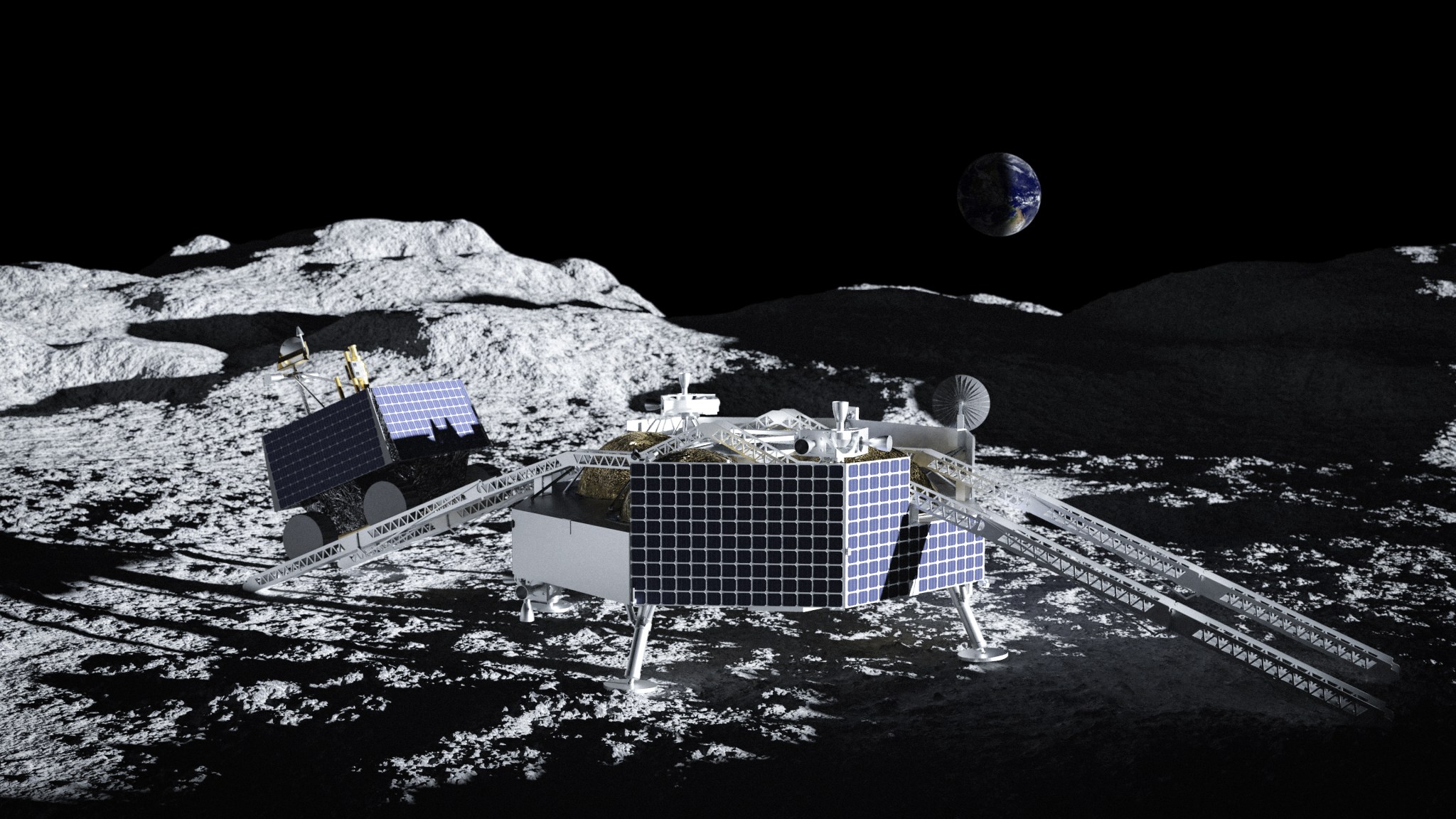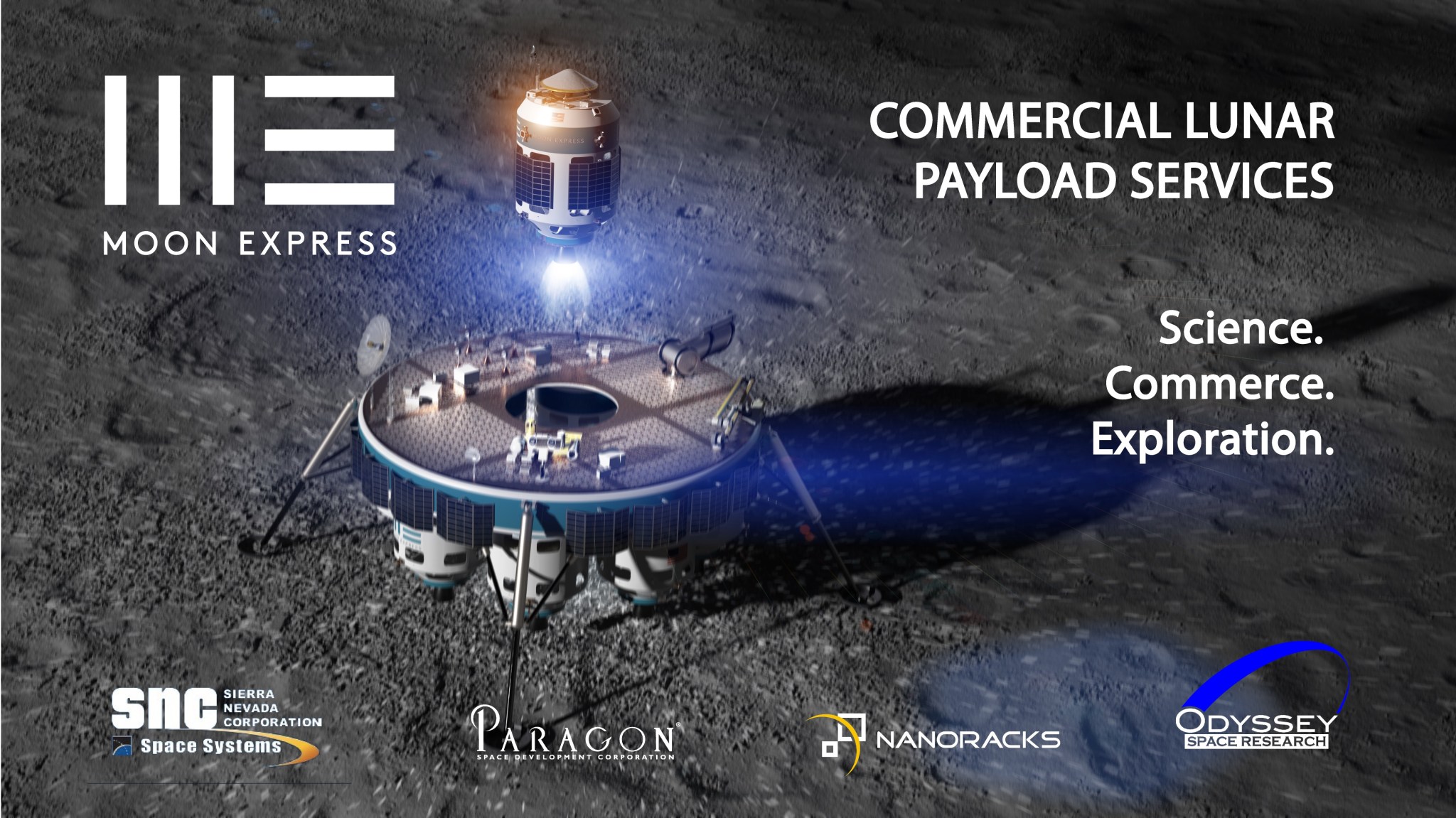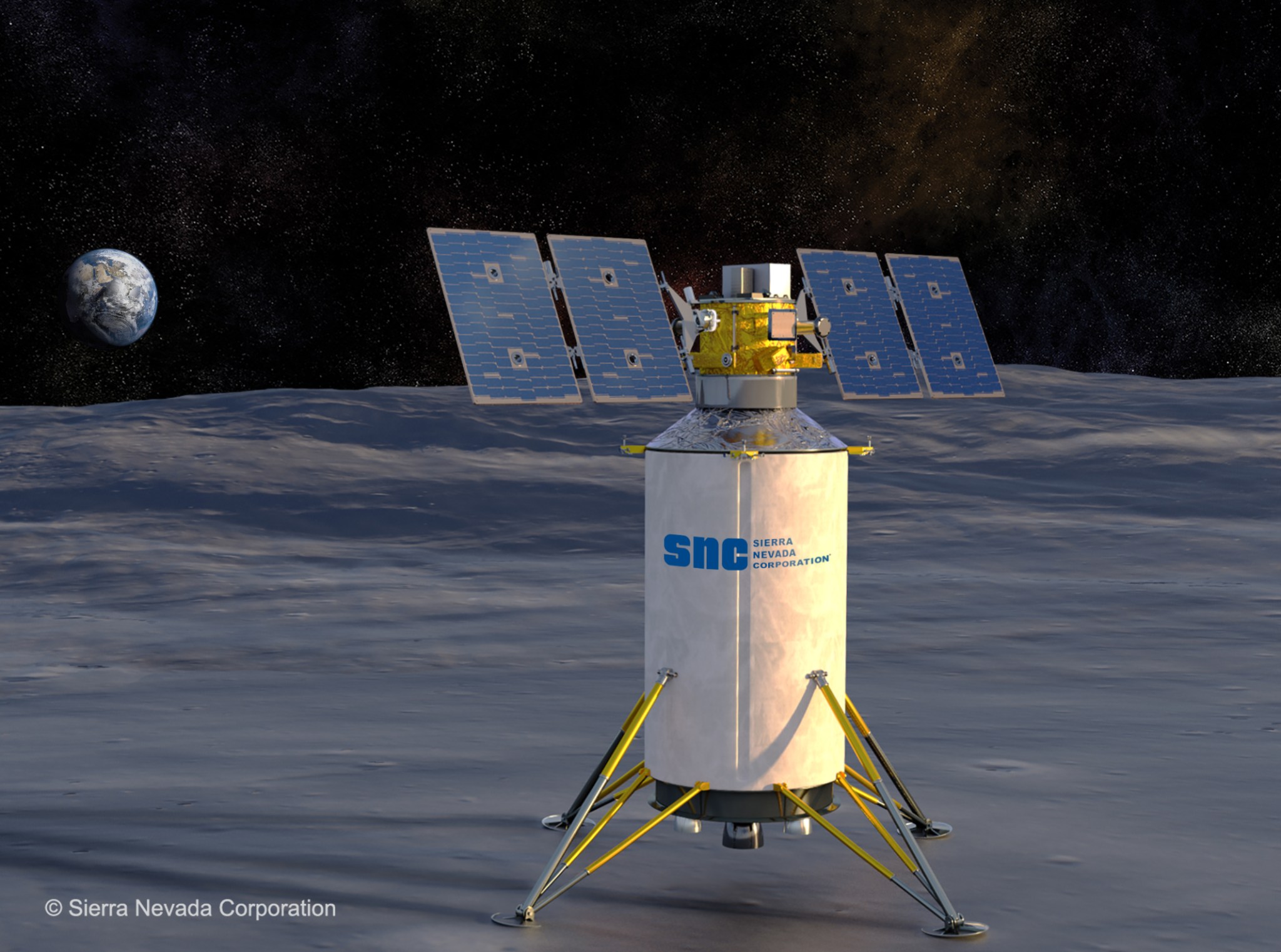Commercial Lunar Payload Services Providers
NASA is working with several American companies to deliver science and technology to the lunar surface through the CLPS initiative.
Astrobotic
Astrobotic was selected to be part of the CLPS vendor pool in 2018, and has been awarded two task orders for scientific payload delivery.
Astrobotic’s Peregrine Mission One made a controlled re-entry on Earth over open water in the South Pacific at approximately 4:04 p.m. EST on Jan. 18.
Astrobotic was the first commercial vendor to launch a mission to the Moon as part of NASA’s CLPS (Commercial Lunar Payload Services) initiative, which aims to advance capabilities for science, exploration or commercial development of the Moon under the agency’s Artemis campaign.
Astrobotic’s second flight is scheduled to land at the lunar South Pole in 2024 using the company’s Griffin lunar lander. The Griffin flight will deliver NASA’s Volatiles Investigating Polar Exploration Rover, (VIPER). VIPER is a solar and battery powered rover that will characterize the distribution and physical state of lunar polar water and other volatiles in cold traps to evaluate the potential for future on-site, or in-situ, resource utilization at the South Pole. VIPER will operate over multiple lunar days and will be capable of traversing into permanently shadowed terrain. Subsurface volatile sampling will be accomplished by a one-meter drill paired with a quadrupole mass spectrometer.
Astrobotic Peregrine Mission One
Status: Completed
Landing Site: Did not land on the Moon
Payloads: https://science.nasa.gov/lunar-discovery/deliveries/to2-astrobotic
Lander Name: Peregrine
Task Order Information: TO2 AB
Astrobotic Griffin Mission-1
Expected Launch Date: 2024
Landing Site: Lunar South Pole
Payloads: https://science.nasa.gov/lunar-discovery/deliveries/20a-astrobotic
Lander Name: Griffin
Task Order Information: TO 20A (VIPER)
Blue Origin
Artist’s concept of a Blue Origin commercial lunar lander on the Moon. Blue Origin was one of five companies announced on Nov. 18, 2019, as taking part in NASA’s Commercial Lunar Payload Services or CLPS initiative. CLPS allows rapid acquisition of lunar delivery services for payloads that advance capabilities for science, exploration, or commercial development of the Moon. Investigations and demonstrations launched on commercial Moon flights will help the agency study Earth’s nearest neighbor under the Artemis program.
Ceres Robotics
Artist’s concept of a Ceres Robotics commercial lunar lander on the Moon. Ceres Robotics was one of five companies announced on Nov. 18, 2019, as taking part in NASA’s Commercial Lunar Payload Services or CLPS initiative. CLPS allows rapid acquisition of lunar delivery services for payloads that advance capabilities for science, exploration, or commercial development of the Moon. Investigations and demonstrations launched on commercial Moon flights will help the agency study Earth’s nearest neighbor under the Artemis program.
Deep Space Systems
This illustration shows a draft concept for a commercial lunar rover from Deep Space Systems, Inc., Littleton, Colo. Deep Space Systems is one of nine companies selected for NASA’s CLPS Initiative. NASA will solicit bids from the companies to provide lunar payloads and services. NASA announced the selection on Nov. 29, 2018.
Draper
In 2022, Draper was awarded one task order for a CLPS delivery. Draper’s first flight is scheduled to land in Schrödinger Basin on the lunar far side in 2025 using Team Draper’s SERIES-2 lander. Payloads include long-lived seismometers to study tectonic activity within the deep lunar interior and micrometeorite impact flux, and a drill to measure heat flow and electrical conductivity probes investigating the near sub-surface.
Team Draper
Expected Launch Date: 2025
Landing Site: Schrödinger Basin
Payloads: https://science.nasa.gov/lunar-discovery/deliveries/cp-12
Lander Name: SERIES-2
Task Order Information: TO CP-12
Firefly Aerospace

Firefly Aerospace has been awarded two task orders for CLPS deliveries. Firefly’s first flight is scheduled to land in Mare Crisium using the company’s Blue Ghost lunar lander. The Blue Ghost Mission 1 will deliver payloads that investigate the heat flow of the lunar interior, plume-surface interactions, and will test regolith sampling technologies. Payloads will also acquire X-ray images of Earth’s magnetosphere and study the structure and composition of the Moon’s mantle by studying crustal electric and magnetic fields. Technology demonstration payloads will look at regolith adherence on different materials, demonstrate the first GNSS fix on the lunar surface, test radiation tolerant computing, and perform a dust mitigation experiment using electrodynamic fields. Mare Crisium is a large, dark, basaltic plain on the Moon that filled an ancient asteroid impact. Basaltic plains on the Moon were created by early volcanic eruptions. Mare Crisium was flooded with basaltic lava, a dark, runny lava commonly found on Earth. Basalts in Mare Crisium range in age from 2.5 to 3.3 billion years old.
Firefly’s second awarded flight, Blue Ghost Mission 2, will deliver two agency payloads to the lunar far side in 2026. The company will also deliver a communications and data relay satellite into lunar orbit that will provide communication services to lunar missions via S-band and UHF links to lunar assets on the surface and in orbit around the Moon and an X-band link to Earth.
CLPS Flight: Blue Ghost Mission 1
Expected Launch Date: 2024
Landing Site: Mare Crisium
Payloads: CLPS Firefly Blue Ghost Mission 1 NASA-Provided Payloads
Lander Name: Blue Ghost
Task Order Information: TO 19D
Rendering of Firefly’s Blue Ghost transfer vehicle deploying the European Space Agency’s Lunar Pathfinder satellite to lunar orbit. ESA’s Lunar Pathfinder is designed and developed by Surrey Satellite Technology Limited. ESA collaborated with NASA for delivery through the CLPS initiative. Credits: Firefly Aerospace
CLPS Flight: Blue Ghost Mission 2
Expected Launch Date: 2026
Landing Site: Lunar far side
Payloads: CLPS Firefly Blue Ghost Mission 2 NASA-Provided Payloads
Lander Name: Blue Ghost
Task Order Information: CS-3
Intuitive Machines
Intuitive Machines was selected to be part of the CLPS vendor pool in 2018 and was awarded three task orders for scientific payload delivery. The first Intuitive Machines flight, IM-1, will use the company’s Nova-C lunar lander and is scheduled to land in mid-February 2024 in the Moon’s South Pole region. The IM-1
flight will carry six NASA payloads that will focus on plume-surface interactions, space weather/lunar surface interactions, radio astronomy, precision landing technologies, and a communication and navigation node for future autonomous navigation technologies. Intuitive Machines’ second awarded flight, IM-2, is scheduled to land at the lunar South Pole in 2024. This will be the first on site, or in-situ, resource utilization demonstration on the Moon utilizing a drill and mass spectrometer to measure the volatile content of subsurface materials. The third Intuitive Machines awarded flight, IM-3, is scheduled to land at the Moon’s Reiner Gamma swirl in 2024 using the Nova-C lunar lander. Payloads include a magnetometer, camera, electron and ion spectrometer, a small rover with a second magnetometer, and a multispectral microscope. This payload suite will study the properties of the Reiner Gamma swirl and its mini-magnetosphere. The delivery also includes a demonstration of swarm robotics technology with the deployment of four small autonomous rovers. Two international payloads will investigate the near-surface radiation environment (South Korea) and an actuated retroreflector provided by the European Space Agency will make high-resolution Earth-Moon distance measurements. Reiner Gamma is a lunar magnetic anomaly known as a lunar swirl located on the lunar near side in Oceanus Procellarum. Lunar swirls are associated with magnetic anomalies in the lunar crust, but more data is needed to understand their formation.
CLPS Flight: IM-1
Launch Window: Starting mid-February, 2024
Landing Site: Malapert A Payloads: https://science.nasa.gov/lunar-discovery/deliveries/op-to2-intuitive-machines
Payloads: https://science.nasa.gov/lunar-discovery/deliveries/op-to2-intuitive-machines
Lander Name: Odysseus
Lander Class: Nova-C
Task Order Information: TO2-IM-1
CLPS Flight: IM-2
Expected Launch Date: 2024
Landing Site: Shackleton Connecting Ridge
Payloads: https://science.nasa.gov/lunar-science/clps-deliveries/prime-1aiintuitive-machines/
Lander Name: Odysseus
Lander Class: Nova-C
Task Order Information: TO Polar Resources Ice Mining Experiment-1 (PRIME-1)
CLPS Flight: IM-3
Expected Launch Date: 2024
Landing Site: Reiner Gamma
Payloads: https://science.nasa.gov/lunar-discovery/deliveries/cp-11
Lander Name: Odysseus
Lander Class: Nova-C
Task Order Information: TO CP-11 (CLPS PRISM 11)
Lockheed Martin Space
This illustration shows a concept for a commercial lunar lander from Lockheed Martin Space, Littleton, Colo. NASA announced Lockheed Martin Space as one of nine companies selected for the Commercial Lunar Payload Services contract on Nov. 29, 2018. The agency will solicit bids from the companies to deliver lunar payloads and services to the Moon over the next decade.
Masten Space Systems
This illustration shows a draft concept for a commercial lunar lander from Masten Space Systems is one of nine companies selected for NASA’s Commercial Lunar Payload Services program. NASA will solicit bids from the companies to provide lunar payloads and services. NASA announced the selection on Nov. 29, 2018.
This illustration shows a concept for a commercial lunar lander from Masten Space Systems of Mojave, Calif. NASA announced Masten Space Systems as one of nine companies selected for the Commercial Lunar Payload Services contract on Nov. 29, 2018. The agency will solicit bids from the companies to deliver lunar payloads and services to the Moon over the next decade.
Moon Express
This illustration shows a concept for a commercial lunar lander from Moon Express, Inc., Cape Canaveral, Fla. NASA announced Moon Express as one of nine companies selected for the Commercial Lunar Payload Services contract on Nov. 29, 2018. The agency will solicit bids from the companies to deliver lunar payloads and services to the Moon over the next decade.
Orbit Beyond
This illustration shows a concept for a commercial lunar lander from Orbit Beyond, Edison, N.J. NASA announced Orbit Beyond as one of nine companies selected for the Commercial Lunar Payload Services contract on Nov. 29, 2018. The agency will solicit bids from the companies to deliver lunar payloads and services to the Moon over the next decade.
Sierra Nevada Corporation
Artist’s concept of a Sierra Nevada Corp. commercial lunar lander on the Moon. Sierra Nevada was one of five companies announced on Nov. 18, 2019, as taking part in NASA’s Commercial Lunar Payload Services or CLPS initiative. CLPS allows rapid acquisition of lunar delivery services for payloads that advance capabilities for science, exploration, or commercial development of the Moon. Investigations and demonstrations launched on commercial Moon flights will help the agency study Earth’s nearest neighbor under the Artemis program.
SpaceX
Artist’s concept of a SpaceX commercial lunar lander on the Moon. SpaceX was one of five companies announced on Nov. 18, 2019, as taking part in NASA’s Commercial Lunar Payload Services or CLPS initiative. CLPS allows rapid acquisition of lunar delivery services for payloads that advance capabilities for science, exploration, or commercial development of the Moon. Investigations and demonstrations launched on commercial Moon flights will help the agency study Earth’s nearest neighbor under the Artemis program.
Tyvak Nano-Satellite Systems
Artist’s concept of a Tyvak Nano-Satellite Systems Inc. commercial lunar lander on the Moon. Tyvak Nano was one of five companies announced on Nov. 18, 2019, as taking part in NASA’s Commercial Lunar Payload Services or CLPS initiative. CLPS allows rapid acquisition of lunar delivery services for payloads that advance capabilities for science, exploration, or commercial development of the Moon. Investigations and demonstrations launched on commercial Moon flights will help the agency study Earth’s nearest neighbor under the Artemis program.








































